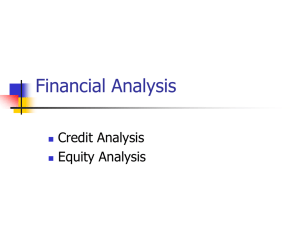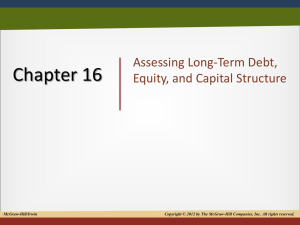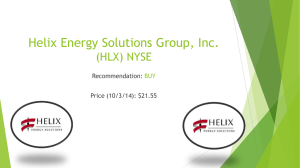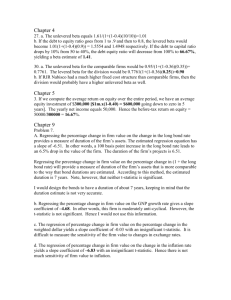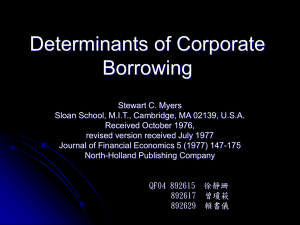THEORY OF CAPITAL STRUCTURE
advertisement
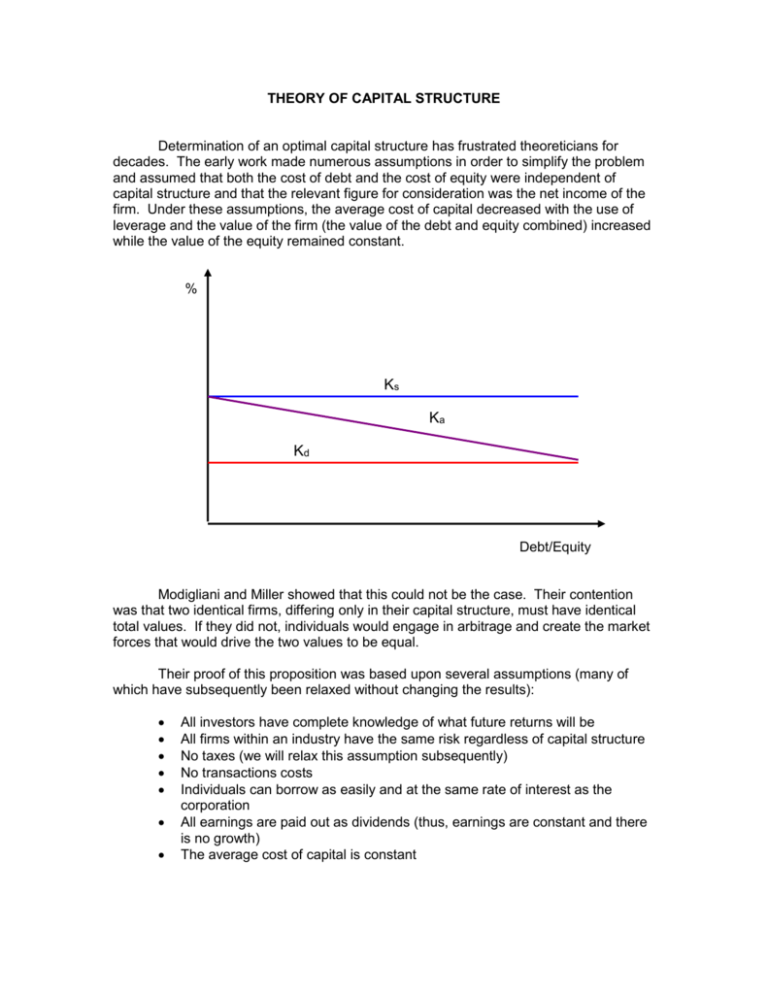
THEORY OF CAPITAL STRUCTURE Determination of an optimal capital structure has frustrated theoreticians for decades. The early work made numerous assumptions in order to simplify the problem and assumed that both the cost of debt and the cost of equity were independent of capital structure and that the relevant figure for consideration was the net income of the firm. Under these assumptions, the average cost of capital decreased with the use of leverage and the value of the firm (the value of the debt and equity combined) increased while the value of the equity remained constant. % Ks Ka Kd Debt/Equity Modigliani and Miller showed that this could not be the case. Their contention was that two identical firms, differing only in their capital structure, must have identical total values. If they did not, individuals would engage in arbitrage and create the market forces that would drive the two values to be equal. Their proof of this proposition was based upon several assumptions (many of which have subsequently been relaxed without changing the results): All investors have complete knowledge of what future returns will be All firms within an industry have the same risk regardless of capital structure No taxes (we will relax this assumption subsequently) No transactions costs Individuals can borrow as easily and at the same rate of interest as the corporation All earnings are paid out as dividends (thus, earnings are constant and there is no growth) The average cost of capital is constant Since no taxes has been assumed, the operating income (EBIT) is equivalent to the net income which is all paid out as dividends. Thus, the value of the firm is equal to V EBIT ka Since the value of the firm is equal to the sum of the value of the debt and equity, V D E then k aV k a ( D E ) and E D ka k s ( ) kd ( ) D E D E Substituting the last equation into the preceding equation and solving for Ks k s ka ( ka kd ) D E Thus, ks must go up as debt is added to the capital structure. % Ks Ka Kd Debt/Equity To prove their point, they assumed two identical firms, an unlevered firm (all equity) and a levered firm with $4 million of debt carrying an interest rate of 7.5%, both firms generating an operating income (EBIT) of $900,000 annually. They adopted the assumption that stockholders of both firms would have the same required rate of return of 10% which, as previously mentioned, was the standard assumption at the time (that the cost of equity was constant regardless of capital structure). EBIT -Interest Income Unlevered Firm $ 900,000 0 $ 900,000 Levered Firm $ 900,000 300,000 $ 600,000 Since the required rate of return of shareholders is 10% in both cases Unlevered Firm Value of Equity = Value of Debt = Total Value of Firm = Levered Firm $900, 000 $9, 000, 000 .10 $600,000 $ 6,000,000 .10 $ 0 $9,000,000 $ 4,000,000 $10,000,000 If this were true, then someone who owns 10% of the levered firm would have income of $60,000 ($600,000 * 10%) and could sell it for $600,000 ($6 million * 10%). With this $600,000 the individual could borrow another $300,000 at 7.5% and buy 10% of the unlevered firm for $900,000 ($9 million * 10%). What would this individual’s income be now? EBIT -Interest Income $ 90,000 22,500 $ 67,500 ($900,000 * 10%) ($300,000 * 7.5%) Thus, the income would be greater by buying the unlevered firm’s stock and borrowing money to finance the purchase. As other individuals see this opportunity, they also will sell the stock of the levered firm (driving its price down) and buy the stock of the unlevered firm (using some borrowed money) and thereby driving the value of the unlevered firm’s stock up. As the price of the unlevered firm is bid up, the value of the unlevered firm increases above $9 million dollars, while the selling of the levered firm’s stock drives the equity value below $6 million (which decreases the total firm value, including the $4 million of debt, below $10 million) until the two firms’ values, in equilibrium, are equal and no opportunity to arbitrage the difference exists. Consequently, if the total value of the two firms is equal, then the average cost of capital must be equal. And if the average cost of capital is equal, then it must be true that the cost of equity rises in such a manner as to exactly offset the increased use of cheaper debt financing (and we end up with the previous graph showing this). As we previously uncovered when we looked at financial leverage, this is not a surprising result. As a firm increases its use of debt, the risk to the stockholder increases and, as a consequence, the stockholder’s required rate of return will increase. Modigliani and Miller simply defined how the stockholder’s required rate of return should increase with increased financial leverage. The lesson that is intended by this is that value cannot be created by simply substituting one form of financing for another. Subsequent to this analysis, it was pointed out that corporate taxes have an impact on the valuation. Without going through the mathematics (which is in your textbook), suffice it to say that the result was that the value of the firm increased with increased leverage. Specifically, VL VU t * D The fact that the government is a “partner” in the business results in a subsidy when debt financing is used and a deductible expense (unlike equity payments). When corporate taxes were taken into account, the average cost of capital was found to decrease with increased leverage: % Ks Ka before-tax Ka after tax Kd before-tax Kd after-tax Debt/Equity This implies that a firm should use as much debt as possible. Yet, we do not see companies using 100% debt. It might be pointed out that during the late 1980s there was a considerable amount of substitution of debt for equity among firms, particularly in the case of leveraged buyouts. However, many of those firms subsequently failed (for example, Unocal) and the typical debt/equity ratio today is similar to earlier levels. So why do we not see more debt employed by companies? The answer to this question has been sought by many and two primary proposals have been put forth. First, bankruptcy costs were invoked as a factor. That is, the more debt a firm uses, the higher the probability that the firm would default and go into bankruptcy. Therefore, the present value of bankruptcy costs had to be deducted from the value of the firm. A second factor was that of “agency” costs, such as the necessity of reporting regularly to lenders (audited financial statements, bank “monitoring” fees, trustees for debt payments, etc.) that accompany the use of debt. Both of these costs increase in present value of expected costs terms as the proportion of debt increases. Another way of viewing these costs is that the risk of receiving full interest and principal payments increases and thus the required rate of return of lenders increases. (For example, “junk” bonds often yield higher rates of interest than the required rate of return on equity for companies with very little debt.) Consequently, the cost of debt increases and the average cost of capital will ultimately increase. % Ks Ka after-tax Kd after-tax Debt/Equity As can be observed from the graph, a minimum average cost of capital exists, but exactly where it should be has yet to be determined within a theoretical framework. So what are the insights that we can gain from this theorectical view of capital structure? First, we should note that, while debt financing is “cheap” in the sense that required rates of return on equity will always be higher than the interest rate on debt, there is a “hidden” cost in that the cost of equity rises as we utilize more debt financing. This is one reason that using the average cost of capital in valuing a project or company is more appropriate, even if we intend to borrow all of the money to finance it. While we may use cheap debt to finance a project, the increased risk to shareholders from increasing our financial leverage results in an increase in the cost of equity. The average cost of capital reflects both the cost of debt as well as the cost of equity and thus will reflect the increased cost of equity associated with the use of more debt financing. The second important concept is that tax-deductible debt financing results in a tax subsidy by the government. This subsidy adds value to the firm. For example, what is the “advantage” of being a home owner with a mortgage rather than leasing a home? It is the taxes that you will save. The reason that Congress eliminated the deductibility of credit card interest is that it did not want to encourage, through a tax subsidy, the financing of purchases purely for consumption. On the other hand, the purchase of a home (which is still tax-deductible) is an “investment”, not to mention the political consequences of voting to end the subsidy of the American Dream of home ownership.



